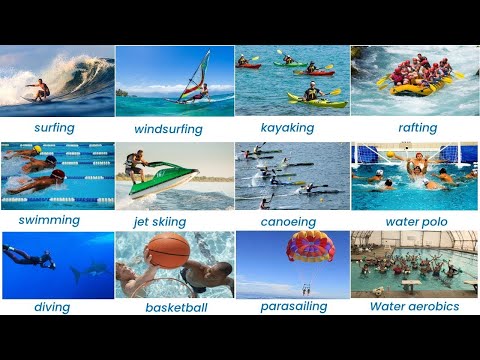What Does Water Sports Mean?
Contents
Water sports are a great way to stay active and have fun in the water. But what does water sports mean? There are a lot of different activities that can fall under this umbrella term. We break down what water sports are and some of the most popular activities that people enjoy.
Checkout this video:
Water sports
Water sports is a catch-all phrase that covers a lot of different activities. Some of these activities, like swimming, are familiar to most people. Others, such as kiteboarding, may be less so. In this article, we’ll explore some of the different activities that fall under the water sports umbrella.
Swimming
Swimming is a sport in which the body is propelled through water by the combined action of the limbs. It can be performed for exercise, recreation, or as a competitive sport. Competitive swimming is one of the most popular sports in the world, with events staged regularly at major international sporting events such as the Olympic Games.
There are a variety of different strokes used in swimming, with each one designed to be the most efficient method of propulsion through water. The four main strokes are freestyle (also known as front crawl), breaststroke, butterfly, and backstroke. In addition to these, there are also a number of other less common strokes such as sidestroke and dog paddle.
Swimming can be performed in a variety of different environments, including rivers, lakes, pools, and even the open ocean. For competitive swimmers, races are typically held in heated pools that are 50 meters (164 feet) in length. Swimmers competing in longer races may use specially designed poolside starting blocks to help them get a good start on their swim.
Scuba Diving
Scuba diving is a mode of underwater diving where the diver uses a self-contained underwater breathing apparatus (scuba), which is completely independent of surface supply, to breathe underwater. Scuba diving is widely considered a safe sport, but, like any sport, there are risks involved.
There are three main types of scuba diving: recreational, technical and commercial. Recreational diving is the most popular type of scuba diving. It is defined as diving that takes place in natural environments without the use of decompression stops or supplemental oxygen. Technical diving is a more advanced form of scuba diving that involves the use of decompression stops and/or supplemental oxygen. Commercial diving is professional diving that involves the use of decompression stops and/or supplemental oxygen.
The three main types of scuba diving are:
-Recreational Diving
-Technical Diving
-Commercial Diving
Surfing
Surfing is a water sport in which the surfer rides a surfboard on the crest and face of a wave, which is usually carrying the surfer towards the shore. Waves suitable for surfing are primarily found in areas with high wind speeds and fetch (the distance over which the wind blows).
Types of water sports
There are many types of water sports, from the relatively sedate activity of fishing to the adrenaline-pumping excitement of water skiing. Some water sports are more popular than others, but all of them have their own unique appeal. In this article, we’ll take a look at some of the most popular types of water sports.
Competitive swimming
Swimming is an individual or team sport that requires the use of one’s arms and legs to move the body through water. The sport takes place in pools or in open-water (e.g., in a sea or lake). Competitive swimming is one of the most popular Olympic sports, with events in butterfly, backstroke, breaststroke, freestyle, and individual medley. In addition to the Olympic events, non-Olympic disciplines include synchronized swimming and water polo.
Recreational swimming
Swimming is one of the most popular recreational activities. Whether you swim for fitness or fun, there are many different strokes you can learn to make your time in the water more enjoyable.
The crawl, also known as freestyle, is the most popular stroke for recreational swimmers. It is a fast stroke that uses alternate arms and legs. This stroke is perfect for those who want to get a good workout while still being able to move quickly through the water.
The breaststroke is another popular choice for recreational swimmers. Unlike the crawl, this stroke keeps your head above water at all times. This can be helpful if you’re not a strong swimmer or if you’re swimming in open water where you need to be able to see what’s around you.
The backstroke is similar to the breaststroke, but you swim on your back instead of your stomach. This can be a good choice if you want to work on your tan while you swim!
Finally, the sidestroke is a slower stroke that is often used by beginner swimmers or those who are swimming for exercise rather than speed. This stroke uses one arm at a time and keeps your head above water at all times.
Water aerobics
Water aerobics is a type of exercise that is done in the water. It can be done by people of all ages and fitness levels, and is often recommended by doctors as a way to stay active when other forms of exercise are not possible. There are many benefits to water aerobics, including improved cardiovascular fitness, muscle strength, and flexibility.
The benefits of water sports
Water sports are a great way to stay active and have fun at the same time. They are also a great way to meet new people and make new friends. Water sports can also help you to improve your fitness levels and to lose weight.
Improves cardiovascular health
Water sports are a great way to improve your cardiovascular health. They are low-impact, so they put less strain on your heart and lungs than other forms of exercise. And, because you are working against the resistance of the water, they give your heart and lungs a good workout.
Reduces stress
Water sport activities have been shown to be very effective in reducing stress. One study found that participants who engaged in water sports had significantly lower levels of the stress hormone cortisol than those who didn’t participate in any water sports. Water sports can also help to improve your sleep quality, as another study found that people who slept after participating in water sports had significantly higher levels of the sleep hormone melatonin.
Increases joint flexibility
Water sports can help with injury rehabilitation as the water provides resistance without putting stress on the joints. The warm water will also help to relax muscles and increase joint flexibility.
The equipment needed for water sports
Before we get into the nitty gritty of what water sports are, we should first define the term. Water sports are any sports or activities that involve water, whether that be in a pool, lake, river, or the ocean. Now that we know what water sports are, let’s talk about the equipment you need for them.
Swimming pool
In order to swim in a pool, you will need the following equipment:
-Swimming goggles to protect your eyes from the chlorinated water
-A bathing suit or swim trunks
-A towel
If you are swimming in a public pool, you will also need to shower before getting into the pool. This is to help keep the pool clean for everyone.
Swimming goggles
Swimming goggles, also known as swim goggles, are eyewear designed to be worn while swimming. Goggles are used to correct or protect vision, or both. Swimming goggles usually have silicone rubber gives or latex straps that fit snugly around the head to keep the goggle in place. Most of swimming goggles also have a nose bridge and a lens cup. The nose bridge keeps the goggle from floating off of the face and the lens cup helps keep water out of the eyes.
Swimming cap
Swimming caps are designed to keep your hair dry and protect your head from the sun. They also help you move through the water more easily. You can find swimming caps made from latex, silicone, or Lycra. Choose a cap that fits snugly but is not too tight.
The different techniques used in water sports
Water sports is a term that covers a wide range of activities. They all have one thing in common, though: they all involve using water in some way. Some popular water sports include swimming, surfing, canoeing, and kayaking.
Breaststroke
Breaststroke is a swimming style in which the swimmer is on their chest and the head remains above water at all times. arms are brought forward together and then swept back to the sides. legs are brought up behind the body and then swept out to the front. hands must be brought back to shoulder width before sweeping forward again. this stroke provides a good deal of resistance to the water, making it ideal for building upper body strength.
Backstroke
Backstroke is a swimming style in which the swimmer lies on their back and kicks their legs to move themselves forward. It is one of the four main strokes used in competitive swimming.
The main difference between backstroke and other swimming styles is that the swimmer floats on their back rather than resting on their stomach or side. This allows them to kick their legs more easily and maintain a more streamlined body position.
Backstroke is often considered to be the easiest of the four main strokes, as it requires less coordination than other strokes such as breaststroke or butterfly. It is also a good choice for beginners as it is less strenuous on the body and doesn’t require as much energy to swim at a fast pace.
There are two main types of backstroke – conventional and inverted. Conventional backstroke is the more common of the two, and is swum with the arms extended above the head. Inverted backstroke is swum with the arms below the hips, and is often used by experienced swimmers who want to challenge themselves with a more difficult stroke.
Butterfly
The butterfly is a swimming stroke swum on the breast, with both arms moving symmetrically, accompanied by kick of the feet resulting in a breaststroke. It is not permitted in competition swimming at the present time. The peak speed of the butterfly is quicker than that of the breaststroke, but since the butterfly incorporates two dolphin kicks per cycle compared to one dolphin kick per cycle in breaststroke, it has less endurance capability than breaststroke.
Competitive swimmers use a number of different techniques to perform the butterfly, as faster times have been achieved with a variety of different styles. Some swim Butterflies with a dolphin kick, while others use an undulating motion of the arms similar to that used in Breaststrokes.







